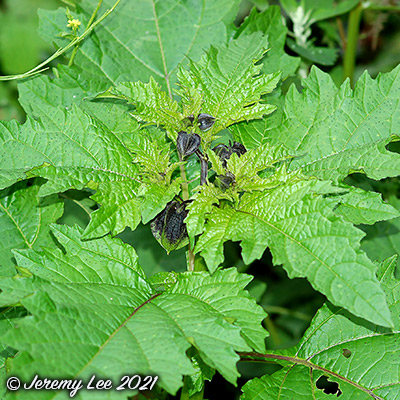
 |
|
Scientific Classifications explained » Amphibians » Ants » Aphids » Bees » Beetles » Birds » Bugs » Butterflies » Caterpillars » Damselflies » Dragonflies » Earwigs » Flies » Frog/Leafhoppers » Fungi » Galls » Grasshoppers » Harvestmen » Hoverflies » Lacewings » Ladybirds » Leaf Mines » Lichens » Mammals » Millipedes » Mosses » Moths » Sawflies » Slugs » Snails » Spiders » Trees & Shrubs » Wasps » Wild Flowers » Woodlice » Postboxes |
UK Nature > Wild Flowers > Blue & Purple Wild Flowers > Nicandra physalodes

Scientific Name: Nicandra physalodes Common Name: Apple-of-Peru, Shoo-fly Plant Nicandra physalodes, more commonly known as Apple-of-Peru or the Shoo-fly Plant, is a large plant which can reach 1.25m in height and 1m across. It has bell-shaped flowers that are most commonly pale blue and white, but there are also forms with violet flowers and with white flowers. The flowers are short-lived, opening for only a few hours each day. It produces cherry-like, green-brown berries which are encased within green or black-mottled calyces rather like Chinese lanterns. It has toothed, ovate green leaves to 10 cm long and rather thin in texture. Usually found as a garden escape or bird seed alien and often close to habitation or in rubbish dumps. It is an annual, its flowers appearing from June to October; widespread but occasional in the UK. |
|

https://www.uknature.co.uk is a website dedicated to showing the immense diversity of UK nature and wildlife. Our vast range of habitats, from lowland arable to snow covered mountains, from storm-ravaged coastlines to peaceful inland freshwater lakes and rivers, from dry, sandy heaths to deciduous and coniferous forests, all these habitats contribute to the abundance of UK nature. We have wild birds in huge numbers either residing or visiting our shores (597 recorded species as at July 2013) and we must also not forget the humble back garden with its grass lawns, flower beds filled with nectar rich flowers, shrubs and trees, all designed to attract huge numbers of insects such as bees, moths, butterflies and hoverflies; and finally the small ponds which provide safe havens for frogs, toads, newts and even slow worms and grass snakes. www.uknature.co.uk is the showcase for my personal passion, photographing uknature in all its glory. I sincerely hope you all enjoy the fruits of my labours. This site and all images contained therein is © Jeremy Lee 2004 - 2025. All Rights Reserved. Site design by Jeremy Lee. Site development & IT Support by Stuart Lee. |